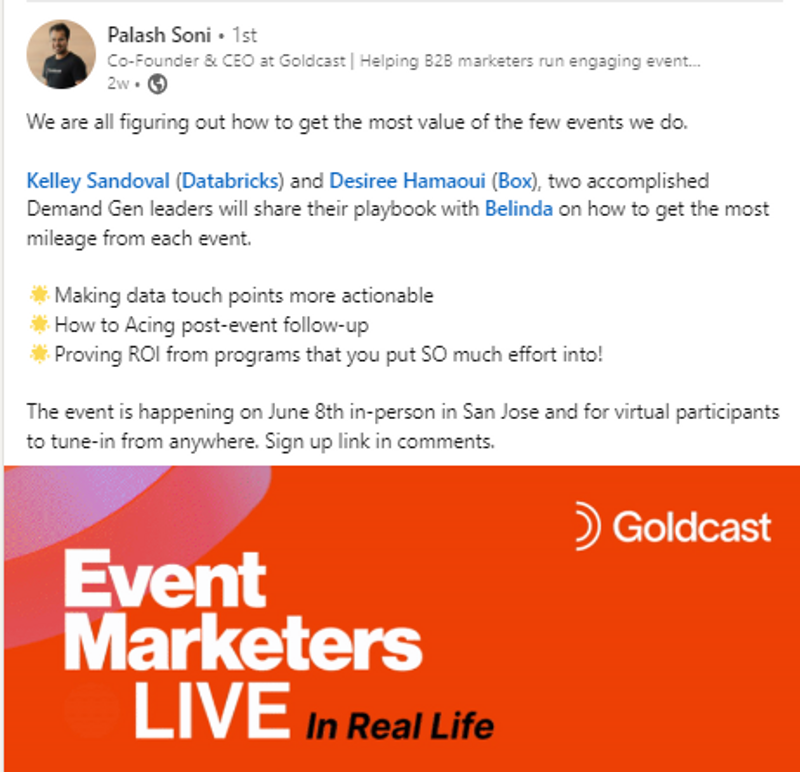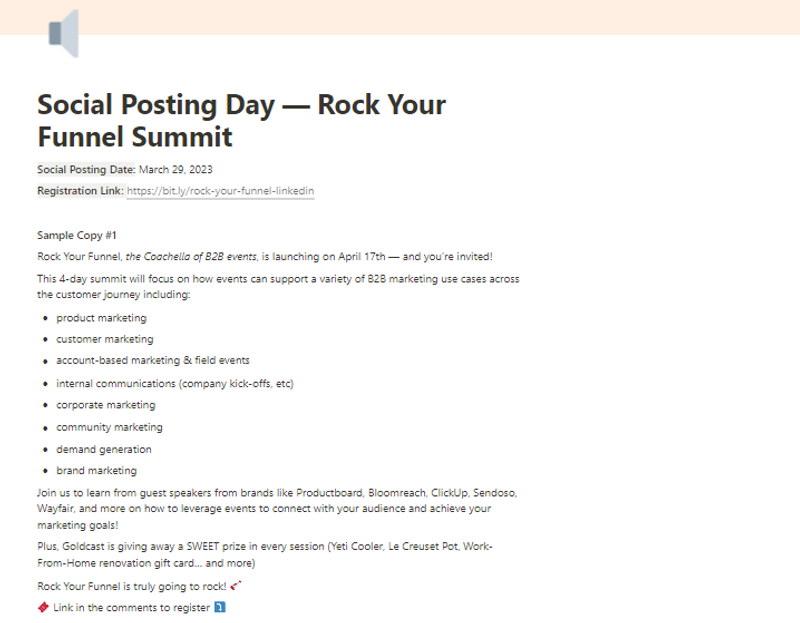Webinar Promotion Simplified: The 5 Most Effective Channels for Registrations
Maximize Your Marketing ROI
Join 10,000 other marketers already getting the best tips on running engaging events that boost pipeline and create raving fans.
Webinars have become a staple in the lives of event marketers and attendees, with companies averaging over one webinar each month.
The short, educational, and easy-to-access nature of a webinar makes this marketing format an easy win for busy professionals who want to level-up in a matter of minutes — not days.
But with popularity comes competition. These days, it can feel harder than ever to secure the webinar registrations you need.
We’re here to help you get webinar promotion down to an art-form. Because the days of wasting your time and energy on promotional channels that don’t move the needle are over. For a future of well-attended, results-driven events, you’ve got to know what works.
5 essential webinar promotion ideas to drive registrations:
- Social media
- Employee enablement
- In-app
- Communities and creators
1. Email 📧
With an already-warm list of subscribers, email marketing is often the most effective webinar promotion channel for sourcing registrations.
But email marketing can be a bit of a minefield. Your webinar promotion emails need to be well timed and positioned to secure those sign-ups.
Here are some ways to improve your webinar email strategy and increase your conversion rate:
- Curate your email list to reach only the most relevant audience — email blasts are no one’s friend.
- A/B test your emails to optimize open and clickthru performance.
- Use countdown timers to encourage recipients to act now.
- Brand your emails for an eye-catching invitation that clinches the registration.
- Tell recipients exactly what you want them to do as early as your subject lines — e.g., ‘grab a seat’.
- Include relevant content to add value to your emails and get readers excited to learn more.
- Add an events section to your regular email newsletter so readers always know where to go to find your latest webinars.
- Plan your webinar email sequence ahead of time so you know exactly what goes out when.
Here’s an example of a webinar email sequence, starting from two weeks out from the event.
T-minus 14 days: The Invite
This email should answer the:
- What: Your webinar topic
- Why: The need for the topic
- When: Date and time
- Who: Speakers and presenters
- How: Your call-to-action (CTA)
Want a little inspo to get the creative juices flowing? Check out these webinar invite email examples from brands like Talogy, ThoughtSpot, and Logikcull.
T-minus 7 days: The Reminder
Customize this email for three specific list segments:
- Registered attendees
- Recipients who opened but didn’t respond
- Those who didn’t open
T-minus 1 day: The Second Reminder
This is your last chance to convert so make sure you’re giving it everything you got, including:
- Webinar date and time
- Add to calendar link
- Single-click webinar join CTA
- Shareable link to invite peers
T-minus 1 hour: The Final Reminder
At this point, you’re mainly looking at reminding registrants to actually show up. Recap the value of your upcoming webinar and include any info that will ease access, such as multiple links to your registration form or a magic link for registered attendees to instantly enter your event.
🔥 Webinar marketing shouldn’t stop at your event reminders. Check out these 10 Free Webinar Follow-Up Email Templates and use your last event’s follow-up email to help promote your next.
2. Social media 📱
Given that nearly 60% of the global population uses social media, this channel still features high on our webinar promotion list.
With the right approach, social media can be an extremely effective way to get in front of a warm audience of fans and followers, while also reaching new audiences via paid ads.
But as with every promotional channel, there are some important nuances to getting it right:
- Be mindful: Every social media channel is its own beast. To effectively promote your webinar, you’ll need custom copy and creatives for each.
- Be realistic: Don’t spread yourself too thin. Stick to the channels that make the most sense for your brand and audience demographic.
- Be committed: Aim for a minimum of one social media post per week on your top two to three channels, more regularly if you’re promoting your webinar via Twitter.
- Be willing to invest in ads: If you have a lower follower count, you may want to use paid social media to help drive registrations through sponsored webinar promotions.
If LinkedIn is one of your top channels, consider tapping into LinkedIn Groups as a way to promote your event. You could even write a LinkedIn post on the webinar topic and the key pain points to be addressed, with a link to the event as your ending CTA.
Last but in no way least, don’t sleep on the power of your employee’s social media interactions as a way to amplify your efforts. (More on that next.👇🏽)

3. Employee enablement 🗣️
As the saying goes, ‘There’s strength in numbers’.
Word of mouth marketing has always been a big factor for prospects who need a little help making a decision. And who better to chime in than your very own (and very awesome) team?
The easier you make it for your team to execute your webinar marketing strategy, the more likely it is they’ll actually do it.
Simplify the process by:
- Creating easily personalized templates that can be copied with ease across platforms.
- Ask employees to add the registration page link to their email signature.
- Share common FAQs in case anyone from their network reaches out.
- Provide general messaging do’s and don'ts — e.g., certain words you don’t want associated with your brand.
- Give everyone access to the creative assets and links they’ll need.
Once they have all the right resources, empower your employees to promote your webinars via their own social channels and in key customer communities. You can even offer workshops and more intensive support to customer-facing teams, for example sales and customer success, who will need to invite customers and prospects via 1:1 outreach.
To spice things up, sweeten the deal with a reward for the team member who does the most to promote your event.
“We asked employees to put our virtual event picture as their display picture on all of their social media platforms and ask their friends to do so as well, with the incentive that one lucky winner would receive a $1,000 gift,” explains Ayman Zaidi, Digital Marketing Manager at GreatPeopleSearch. “This out-of-the-box strategy proved to be beneficial in promoting the virtual event successfully and gaining us more registrations.”

4. In-app promotion 📢
Webinar promotion shouldn’t just target prospects and leads. Your existing customer base can also be a great source of relevant registrations.
This is especially perfect if you’re promoting a customer-focused webinar.
If you have a free trial or self-serve experience, use A/B targeting to target only these users. Then adjust your in-app targeting to only reach the most relevant cohort. You can even adjust your messaging for different types of users based on their needs.
Here are a couple of places to position your in-app promotions so that they’re sure to be seen:
- Add a call to action on your app login page for instant visibility.
- Use app pop-ups that can be triggered using key user criteria.
- Promote via banner, sound, and preview alerts in the user’s notification center.
- Drop registration links in your app resource center.
You can even make your webinar content available on-demand by adding it to a dedicated section of your resource center to help build awareness for future events.
5. Communities and creators 🤩
Sponsoring relevant communities or creators can be a great alternative to traditional advertising.
With the right partnership, including a clear alignment on target audience, you can easily leverage a creators’ platform to build credibility, or even create engaging webinar experiences exclusively for their audiences.
For example, SAP invited five influencers to speak about machine learning and data analytics at a customer event in Germany. These five speakers ended up driving 50% of all mentions about the event on social media — the event was trending in Germany for two days straight.
SAP then replicated this approach for their annual user conference by collaborating with 11 influencers to reach over 80,000 online viewers, in addition to the 20,000 live attendees. That’s the exponential power of having the right partnerships.
Here are some tips to help keep your collaborations productive:
- Make sure your values and audiences align. Confirm that your prospects are members of their audience and that they are genuinely influential to the people you want to engage.
- Build relationships with creators as early as possible so you can share their content, promote their sessions in your social posts, and make them an active part of your webinar promotion strategy.
- Work with creators and partners on creating custom swag to help incentivize registrations.
Don’t be afraid to think outside the box about who makes a good promotional partner.
Influencers are great, but there’s no reason your partners, sponsors, and speakers can’t also help promote your next event. Early in the relationship, be sure to ask where they stand on leveraging their connections and email lists to help drive awareness.
Best practices for webinar marketing success ✅
So you’ve perfected your webinar promo — kudos to you!
Remember, you still need to make sure your registered attendees actually show up.
Here are a few more tips to help boost your attendance rate:
- Use UTM links: To track attribution and keep tabs on what’s working and what’s not. Be sure to create unique links for each channel, all the way down to individual sales reps, to see who can drive the most registrations.
- Optimize your registration page: Your webinar needs to stand out and make a great first impression, starting with a high-quality webinar landing page.
- Calendar holds: This feature automatically holds a date in the prospects calendar to ensure no one forgets. May sound simple, but it’s the best way to boost your attendance rate.
- Stay in tune with webinar best practices: From the best days and times to host your webinar, to the optimum length, name, attendee count and engagement levels, our B2B Webinar Benchmark Report has you covered.
Create a webinar promotion strategy that does more with less
Webinars are a maverick in the world of marketing. But that doesn’t mean you have all the time in the world to experiment with every promotion tactic out there.
Secure more registrations with less effort by focusing on the webinar registration channels proven to work best for your brand and target audience. Before you know it, webinars will be one of the most productive formats in your marketing strategy.

Transform Your Video Marketing with AI
Stay In Touch
Platform
Resources
© 2025 Copyright Goldcast, Inc. All rights reserved.





 Upcoming Events
Upcoming Events Event Series
Event Series On-Demand Events
On-Demand Events

